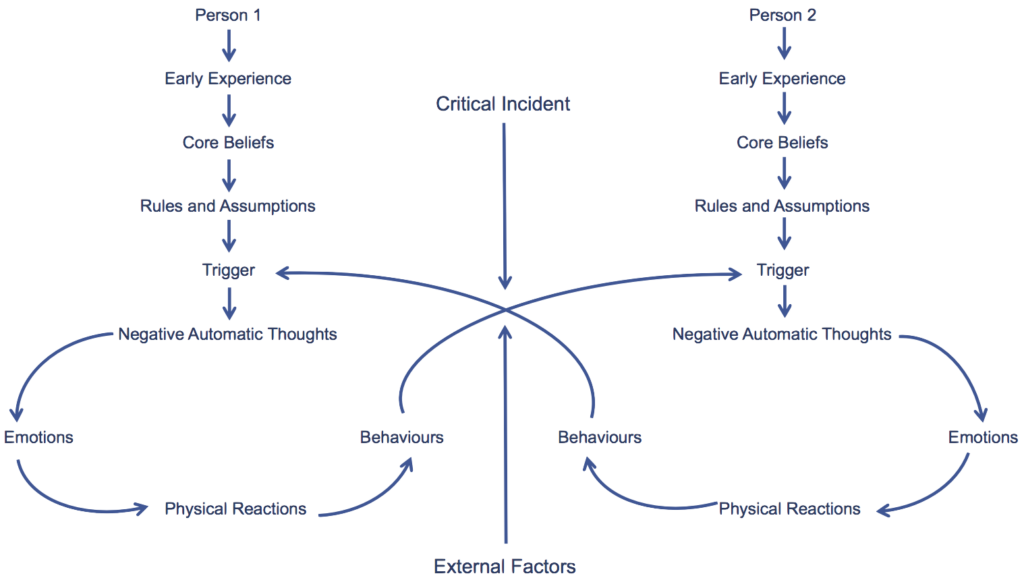Every intimate relationship goes through its ups and down. It is a part of the two individuals involved being human.
For the majority, intimate relationships are very important and significantly influence their overall health and well-being. Intimate relationships that are fulfilling can bring enjoyment and social support and be a buffer against the effects of many pressures. However, these relationships can also cause adverse effects on physical and psychological health and severe suffering when marked by intense distress, destructive disputes, or overall relationship unhappiness. That said, most relationships overcome these problems though sometimes it may require help from trained professionals.
Cognitive Behavioural Couples Therapy (CBCT) can offer a planned and practical method for resolving disagreements within relationships, enhancing engagement or communication, and re-establishing emotional intimacy.
How do problems arise in intimate relationships?
In most partnerships, individual differences and opinions exist, which increases the likelihood of friction and conflict. Communication breaks down, a negative emotional tone takes over, and the emphasis switches from collaboration to resistance or withdrawal when these relationship disagreements are not respectfully and assertively addressed.
There are several factors within the relationship that might keep this pattern going. Some of these factors are:
- A decrease in positive emotional reciprocity; showing less concern or concern for one another.
- Unhelpful demands or expectations from one or both participants in the relationship.
- Unresolved disparities in values and attitudes.
- Problems with communication and unproductive communication habits.
- Physical or emotional abuse.
- Cycles of pursue-withdraw, attack-withdraw, and withdraw-withdraw are used in resistance patterns.
- Individual destructive or addictive behaviors that harm the partnership.
- Inappropriate relationship behaviors and infidelity
Leading marital therapist John Gottman’s research demonstrates that it is possible to forecast whether a relationship would succeed or fail with 96% accuracy. This is determined by the presence of “Four Horsemen of the Relationship Apocalypse.” These are negative thinking, behavior, and emotional patterns within a relationship during the conflict.
Criticism is the first of the four horsemen. Offering a critique or raising a concern is not the same as criticizing. The former two are about particular problems, but the latter is a personal assault that uses blame, character assassination, and over-generalizations like ‘always,’ ‘never, “should,’ etc.
Contempt is the second horseman. While criticism assaults the partner’s character, contempt asserts moral superiority over the other. Mockery, sarcasm, and insults in verbal and nonverbal styles make the subject of contempt feel inferior and worthless. Contempt is driven by long-simmering unfavorable sentiments and is the best predictor of divorce.
Defensiveness is the third horseman, which is usually defensiveness to criticism. Defensiveness is self-protection through counter-attacks, playing innocent victims, making explanations, etc. It does not allow for healthy conflict resolution since it sustains a state of contention.
Stonewalling is the fourth horseman’s answer to contempt. Stonewalling happens when the listener withdraws from the engagement and tunes out their companion. It involves evasion, pretending to be busy, or indulging in distractions rather than confronting the issue.
For what problems do couples go to a CBCT therapist?
- Conflicts and violence
- Infidelity/Affairs
- Infertility(?!)
- Individual problems
- Relationship in a rut
- Pre divorce
- Crisis intervention
What is CBCT?
The origins of Cognitive Behavioural Couples Therapy lie in the work of RB Stuart about the behavioral exchanges between partners.
In recent years, behavioral couple therapy has grown to include strategies that also deal with the emotions and thoughts that fuel arguments and unhappiness. This was accomplished by emphasizing the significance of attributions, dysfunctional beliefs, and distorted cognitions in assessing romantic partners’ relationships.
By recognizing and questioning the processes at work in partners’ interactions while considering the outside circumstances that might affect them, CBCT’s major goal is to assist couples in understanding their issues to improve their relationship well-being. To achieve this, CBCT emphasizes the importance of focusing on numerous cognitive, emotional, and environmental elements that impact a couple’s functioning and relying on behavioral treatments in the therapy of relationship issues.
The CBCT model is depicted as a “butterfly” image to help demonstrate the interaction between personal, interpersonal, and environmental elements. This illustrates how these interdependencies may sustain conflict and produce a vicious cycle.

CBCT techniques help couples identify, control, and express the overwhelming unhealthy negative emotions and thoughts that develop when conflict arises. Couples who undergo CBCT therapy also learn to recognize the effects their behaviors, thoughts, interpretations, and feelings have on their relationship and how to notice and adjust their automatic negative thoughts, assumptions, and standards.
What are the various phases of CBCT?
The CBCT protocol is divided into six phases. These steps can be used to explicitly target and address specific challenges, albeit they are often done sequentially.
1. Conduct a collaborative assessment to recognize and evaluate interpersonal disputes, personal issues, and outside influences.
2. Deciding on shared values and goals to provide direction and steer upcoming relationship adjustments.
3. Investigating the connections between external events, triggers, thoughts, feelings, and behaviors using the CBCT model.
4. Finding and using new cognitive and behavioral techniques based on shared principles, respect for one another, empathy, confidence, and tolerance
5. Working on active listening and communication techniques to promote positive behavioral change.
6. Drafting a new “relationship contract.” This articulates the core values that each partner commits to, facilitating behavior change and continuity after the couple’s therapy is over.
What are the commonly used techniques in CBCT?
While each couple and their problems are unique, they follow a pattern, as we have seen above. Thus, a set of commonly used techniques is used and taught to almost every couple who undergoes CBCT.
Communication training
A key component of CBCT is communication training, which tries to improve how partners learn to communicate and listen without judgment or criticism. Interestingly, this form of counseling has shown visible short-term effects, even in distraught couples. This is often done by role-playing the problematic conversation in the therapist’s office.
Problem and conflict resolution
Many couples simply don’t know how to problem solve as individuals and thus cannot do so as a couple. During CBCT, couples are taught and practice the following five steps of problem-solving
- Defining the problem
- Understand the meaning of the problem and thus the needs of each partner
- Brainstorming of possible solutions
- Selecting a solution that seems the best for both
- Trial period with the suggested solution
Cognitive restructuring
The cognitive restructuring interventions employed in CBCT aim to assist couples in identifying and assessing the suitability of their thought patterns. They also help partners examine their beliefs about their relationship that negatively impact their emotional and behavioral responses to them. Learning about one another’s perspectives and how they interpret events, these techniques helps couples see their relationship from a wider angle. Additionally, partners will start to anticipate how such interpretations affect their relationships.
Identification and expression of emotions
The therapist helps partners define and control avoided emotions rather than suppress them since some negative or powerful emotions, such as anger or fear, are frequently avoided by partners.
Techniques include:
- Encouraging partners to care for and support each other when they express emotions.
- Normalizing the expression of both positive and negative emotions.
- Directing partners to stay focused on their emotional experiences rather than focusing only on more cognitive or behavioral aspects of an incident.
Expression of affection and sexual problems
Many couples frequently need education about simply expressing their sexual needs and problems. A CBCT therapist will often refer the couple to someone who is an expert in sexual dysfunctions if they feel the problem has a biological underpinning.
Acceptance and tolerance of differences
Strategies to improve acceptance aim to provide partners with fresh perspectives on their issues through empathetic joining and united detachment. By allowing each partner to express their viewpoint on a problem while being listened to by the other partner and the therapist, whose job is to encourage the expression of emotions rather than making accusations or comments on behaviors, empathic joining highlights each partner’s sense of vulnerability.
Conclusion
According to the scientific literature, CBCT is a very successful therapeutic strategy for enhancing relationship health and a technique to handle numerous challenges and concerns that couples may have. This is particularly true for communication, problem-solving, and conflict-resolution challenges that develop naturally between partners or as a result of co-occurring psychological issues in one or both partners, for which specific techniques have been developed and are frequently used by couple therapists. Want to talk more about cognitive behavioral couples therapy? Have a virtual coffee with me

I help IT executives overcome anxiety, overwhelm and procrastination, unleashing their potential using 1:1 CBT sessions | Assertiveness Training | Burn-out Prevention | Beat Perfectionism | Crush Imposter Syndrome
